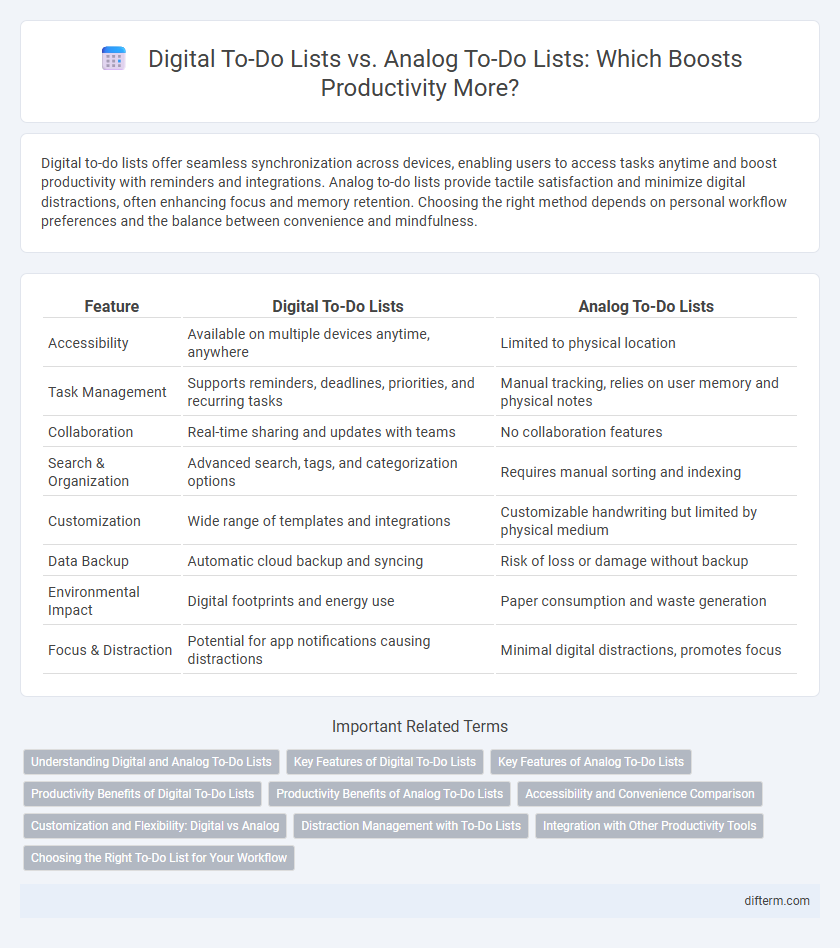Digital to-do lists offer seamless synchronization across devices, enabling users to access tasks anytime and boost productivity with reminders and integrations. Analog to-do lists provide tactile satisfaction and minimize digital distractions, often enhancing focus and memory retention. Choosing the right method depends on personal workflow preferences and the balance between convenience and mindfulness.
Table of Comparison
| Feature | Digital To-Do Lists | Analog To-Do Lists |
|---|---|---|
| Accessibility | Available on multiple devices anytime, anywhere | Limited to physical location |
| Task Management | Supports reminders, deadlines, priorities, and recurring tasks | Manual tracking, relies on user memory and physical notes |
| Collaboration | Real-time sharing and updates with teams | No collaboration features |
| Search & Organization | Advanced search, tags, and categorization options | Requires manual sorting and indexing |
| Customization | Wide range of templates and integrations | Customizable handwriting but limited by physical medium |
| Data Backup | Automatic cloud backup and syncing | Risk of loss or damage without backup |
| Environmental Impact | Digital footprints and energy use | Paper consumption and waste generation |
| Focus & Distraction | Potential for app notifications causing distractions | Minimal digital distractions, promotes focus |
Understanding Digital and Analog To-Do Lists
Digital to-do lists offer dynamic features such as reminders, synchronization across multiple devices, and integration with calendars, enhancing real-time task management. Analog to-do lists provide tactile engagement and reduce digital distractions, often improving focus and memory retention through handwritten notes. Understanding the strengths and limitations of both formats helps optimize productivity strategies tailored to individual work styles and environments.
Key Features of Digital To-Do Lists
Digital to-do lists offer key features such as real-time synchronization across multiple devices, customizable reminders, and integration with calendars and email platforms. Advanced functionalities include priority tagging, progress tracking, and collaboration tools that enhance task management efficiency. These features provide greater flexibility and accessibility compared to analog to-do lists, making digital solutions ideal for dynamic productivity environments.
Key Features of Analog To-Do Lists
Analog to-do lists offer tactile engagement and enhanced memory retention through physical writing, supporting cognitive processing and reducing digital distractions. Their simplicity and flexibility allow for easy customization without reliance on electronic devices, which is ideal for quick note-taking and prioritization. The ability to visualize tasks on paper fosters a stronger sense of accomplishment and organization, contributing to effective time management.
Productivity Benefits of Digital To-Do Lists
Digital to-do lists enhance productivity by offering features like real-time synchronization across multiple devices, customizable reminders, and integration with calendars and project management tools, ensuring tasks are never overlooked. Advanced search functions and categorization options enable users to prioritize and organize tasks more efficiently than analog lists. Moreover, digital platforms often provide analytics and progress tracking, helping individuals optimize their workflow and time management.
Productivity Benefits of Analog To-Do Lists
Analog to-do lists enhance productivity by minimizing digital distractions and fostering better memory retention through tactile engagement. Writing tasks by hand strengthens cognitive processing, leading to higher task recall and prioritization accuracy. This method also encourages sustained focus and reduces screen fatigue, resulting in more efficient task completion.
Accessibility and Convenience Comparison
Digital to-do lists offer superior accessibility with cloud synchronization across multiple devices, allowing users to update tasks in real-time from smartphones, tablets, or computers. Analog to-do lists provide tactile engagement and simplicity without requiring battery life or internet connection, ensuring reliability in any environment. Convenience favors digital tools due to features like reminders, search functions, and easy editing, while analog lists excel in reducing digital distractions and fostering focus.
Customization and Flexibility: Digital vs Analog
Digital to-do lists offer extensive customization with features like tags, reminders, and integrations that streamline task management across devices, enhancing flexibility for dynamic schedules. Analog to-do lists provide tactile control and free-form note-taking, allowing personalized layouts and spontaneous adjustments without technical constraints. Choosing between digital and analog depends on whether users prioritize seamless updates and automation or hands-on customization and flexibility.
Distraction Management with To-Do Lists
Digital to-do lists offer built-in features like notifications and easy task updates, but they can increase distraction due to app-switching and incoming alerts. Analog to-do lists reduce digital interruptions, promoting focused task management by eliminating constant online connectivity. Effective distraction management in productivity relies on choosing a system that minimizes cognitive overload and aligns with individual workflow preferences.
Integration with Other Productivity Tools
Digital to-do lists excel in integration with other productivity tools such as calendars, email clients, and project management apps, enabling seamless task synchronization and automated reminders. These integrations enhance workflow efficiency by centralizing task tracking and facilitating real-time updates across devices. In contrast, analog to-do lists lack direct connectivity, requiring manual effort to update or transfer information, which can reduce overall productivity.
Choosing the Right To-Do List for Your Workflow
Digital to-do lists offer seamless synchronization across devices and integration with calendar apps, enhancing real-time task management for dynamic workflows. Analog to-do lists, favored for their tactile engagement and simplicity, reduce digital distractions and improve focus through physical writing. Selecting the right to-do list depends on workflow complexity, preference for mobility, and the need for customizable reminders or prioritization features.
digital to-do lists vs analog to-do lists Infographic

 difterm.com
difterm.com